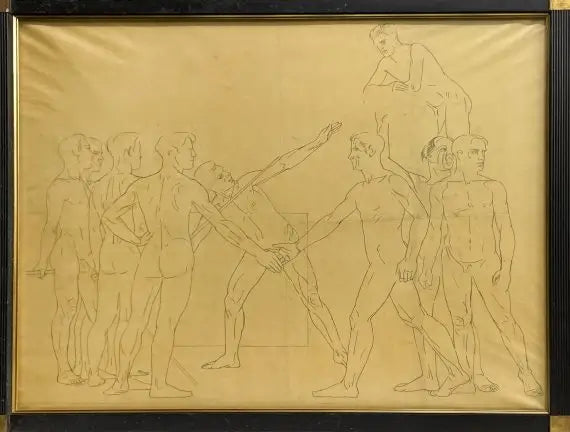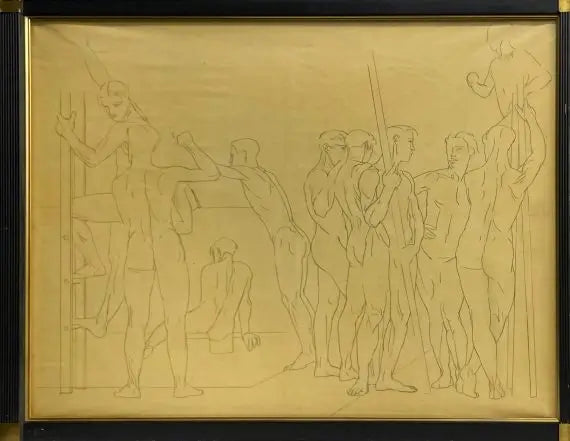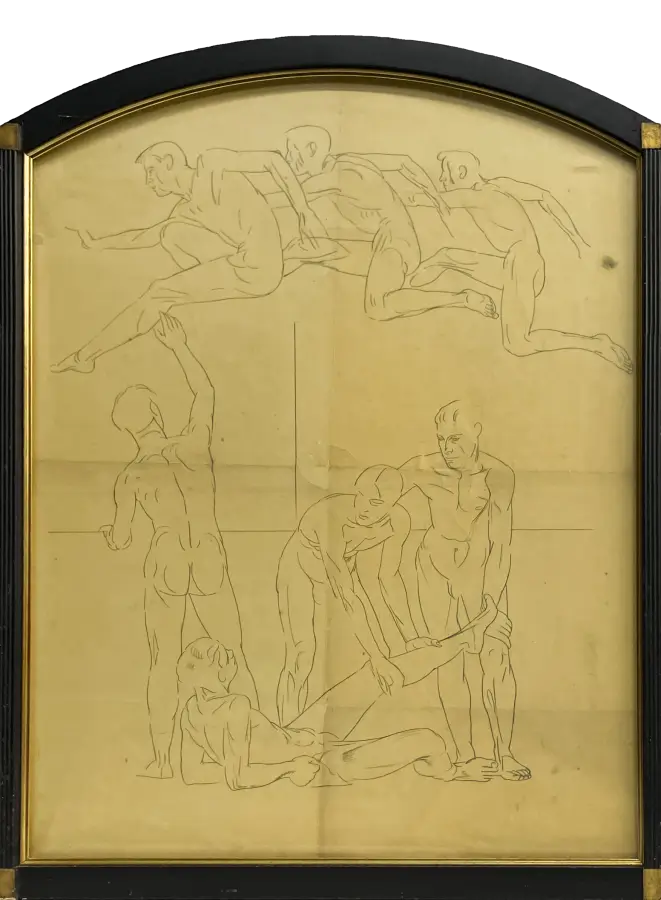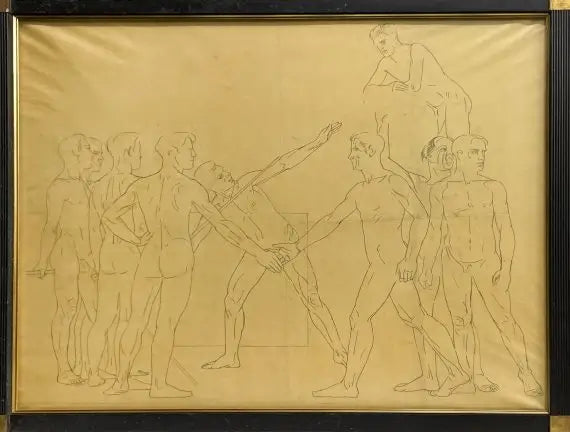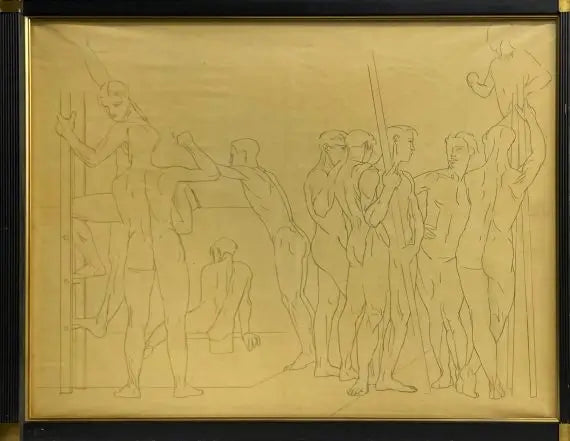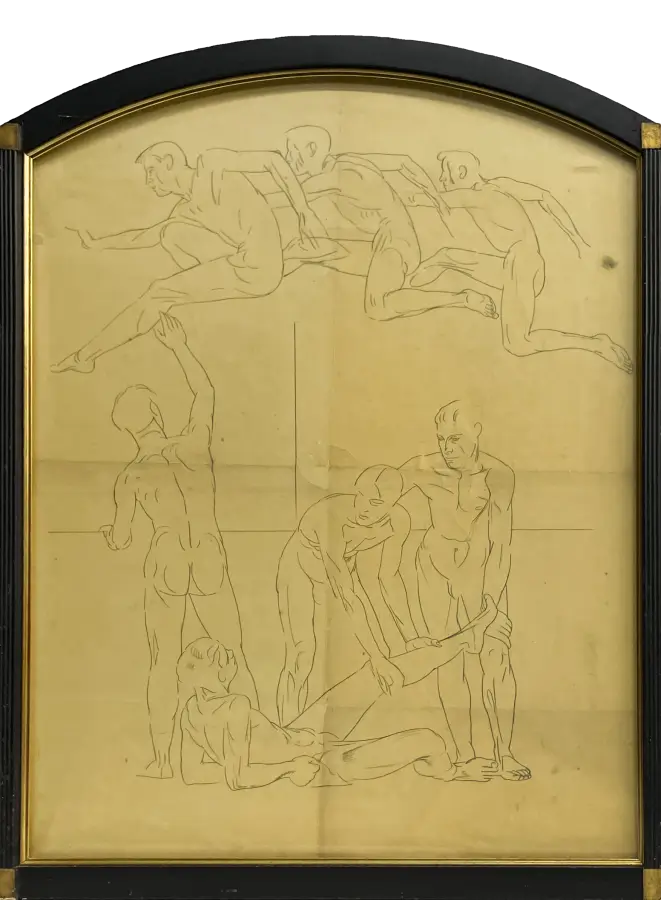

James Stroudley
A Triptych: The Olympic Games
Graphite on paper
Image size of rectangular works: 33 x 43 inches (84 x 109 cm)
Image size of arched central work: 38 1/4 x 29 inches (97 x 73.5 cm)
Provenance
Private Collection of Seymour Stein, Vice President of Warner Bros Records
Sotheby’s ‘Modern British and Irish Art,’ London, 19 May 2004, lot 92
The three impressive drawings are studies for Stroudley’s ‘Olympic Games in a Demi-Lune’. From left to right the studies depict groups of athletes practicing diving, a conversing crowd of oarsmen, hurdlers mid jump and a collection of javelin throwers. This study was created in 1930 when Stroudley practiced in the British School in Rome.
There are few surviving works from Stroudley’s short stay in Rome, with the compositions from his Rome period being among the last wholly successful decorative cycles produced by a Rome Scholar prior to World War II. Indeed, as can be seen here, his drawings from this period are technically brilliant and even bear comparison with those of Eric Kennington.
James Stroudley
Stroudley was born in London on 17 June 1906, the son of James Stroudley, showcard and ticket writer. He studied at Clapham School of Art (1923-27) and then at the Royal College of Art (1927-30), where his teachers included Alan Gwynne-Jones and William Rothenstein. As a recipient of the first Abbey Scholarship he was able to spend three years in Italy from 1930, where he absorbed the influences of Giotto and Piero della Francesca, and produced one of the last wholly satisfying decorative cycles by a Rome Scholar of the period. From 1934, he exhibited at the Royal Society of British Artists, and was elected to its membership in the following year.
From the Second World War – in which he worked with the Camouflage Unit – Stroudley taught at St Martin’s School of Art and was a visiting lecturer at the Royal Academy Schools. Though he continued to live in London, his later work, exhibited at the Royal Academy from 1955, indicated regular painting trips to Kent and Sussex coasts. However, much of his later work was abstract. In 1971, his former student, Peter Coker, paid homage to Stroudley by including his work in the exhibition ‘Pupil & Masters’, held at Westgate House, Long Melford, Suffolk.
Stroudley married three times, and his wives included the fashion artist to the Sun newspaper, designer and writer, Phyllis Neuland, with whom he had one son; and the painter and printmaker, Gillian Thain, with whom he had two sons and one daughter. Stroudley died in Wandsworth, London, in May 1985.
Seymour Stein
Legendary Sire Records co-founder, Seymour Stein, kick-started the era of punk and new wave music in the 1970s and ‘80s, by signing to the label such iconic artists as the Ramones, The Smiths, Talking Heads, Depeche Mode, Ice-T, and famously, in 1982, Madonna. He was inducted into the Rock and Roll Hall of Fame in 2005.
Beginning in the early 1970s, while traveling as a young businessman throughout Europe, Stein developed an enthusiasm for early 20th-century art. Wherever he went, he sought out antique stores, art fairs, and major auction houses — ultimately forging a vast collection.
The Collecting Eye of Seymour Stein, Sotheby’s 2003 auction showcased Stein’s interest in Art Deco furniture and porcelain, metalwork and glassware, European Symbolist and Pre-Raphaelite paintings. Works from the distinguished collection were also included in Sotheby’s 2018, Victorian, Pre-Raphaelite & British Impressionist Art, auction.
Seymour Stein passed on April 2nd, 2023.

